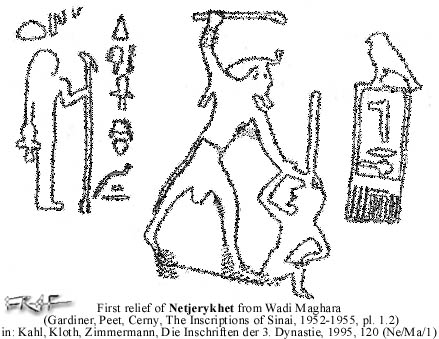It looks like you're using an Ad Blocker.
Please white-list or disable AboveTopSecret.com in your ad-blocking tool.
Thank you.
Some features of ATS will be disabled while you continue to use an ad-blocker.
8
share:
Considered one of the most important archaeological necropolis’ of Ancient Egypt but little known outside of Egyptology, the sacred site ofUmm
el-Qa'ab, is located near the ruins of Abydos
The map below shows the location of the necropolis in relation to the more famous Abydos

The scene today
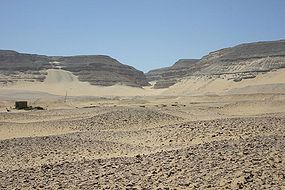
A detail and location of the major burials
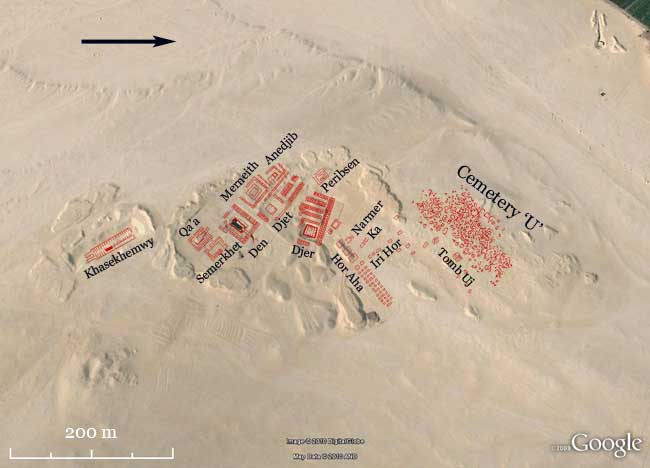
The site contains the burials of pre-dynastic kings or nobles
U-J, Serket I sometimes called teh Scorpion King, Iry-Hor and Ka
Iry-Hor the oldest attested ruler of Egypt known by name
Ka Pharaoh of Thinis
There are also nine 1st dynasty tombs and two 2nd dynasty tombs which will be specifally addressed in the next post - now to more general items
Sacrifice was part of the epitaphic rituals of the first dynasty. The sacrificed, such as servant and asses, were expected to assist the pharaoh in the afterlife. The tomb of Djer is associated with the burials of 338 individuals thought to have been sacrificed. The Djer's courtiers were smothered and their tombs all closed at the same time. This practice ended with the conclusion of the dynasty, with the idea of shabtis taking the place of the sacrifices to aid the pharaohs in the afterlife
The tombs of Umm el-Qaab
The tombs themselves
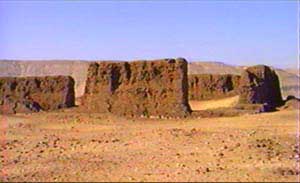
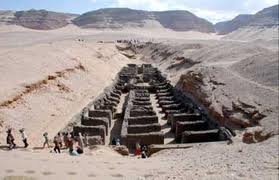
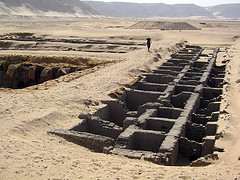
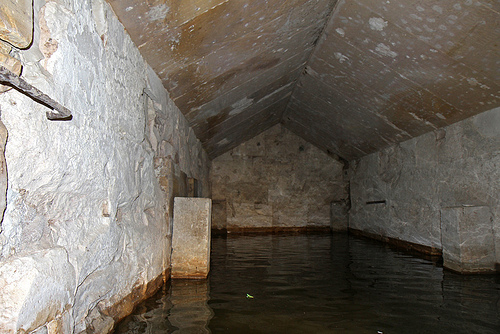
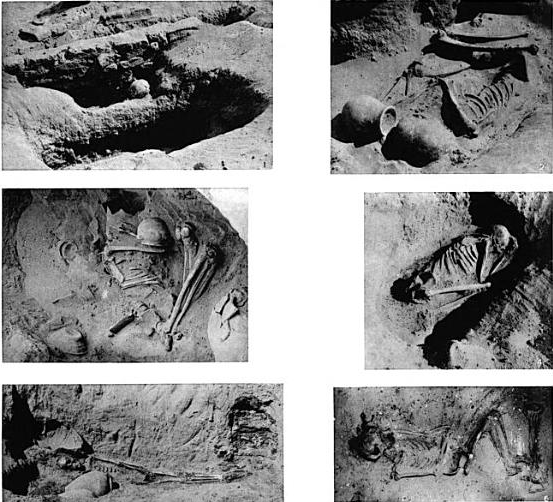
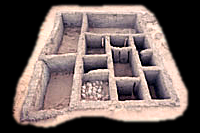
Images of items found in the tombs, Images of items found in the tombs
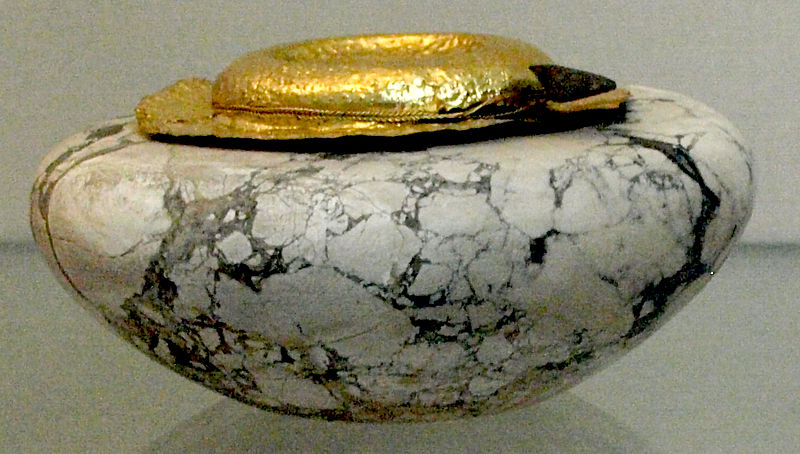
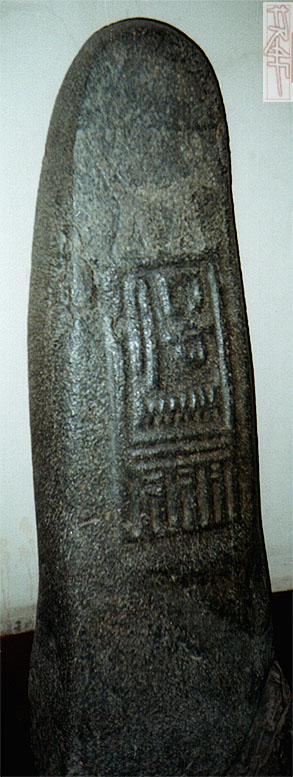
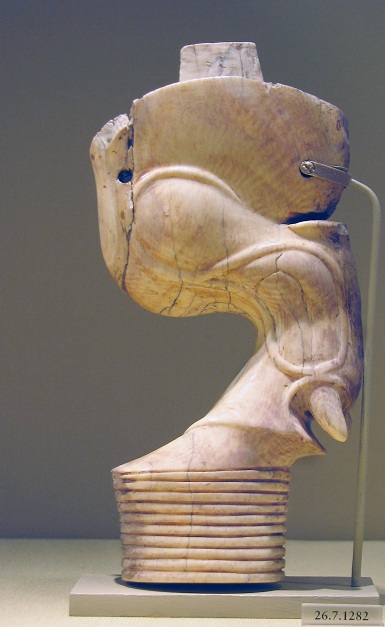
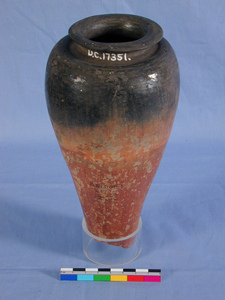
DAI, German Archaeological Institute The DAI, German Archaeological Institute has been working at the site for 40 years
The site was one of pilgrimage for thousands of years for ancient Egyptians and the most common offerings came in redware pottery
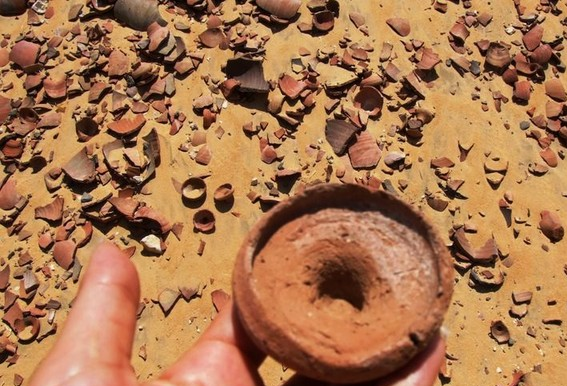

There are acres of these sherds often to the depth of 4 meters
Book on the necropolis books.google.com...=onepage&q=Umm %20el-Qa'ab&f=false
The map below shows the location of the necropolis in relation to the more famous Abydos

The scene today

A detail and location of the major burials

The site contains the burials of pre-dynastic kings or nobles
U-J, Serket I sometimes called teh Scorpion King, Iry-Hor and Ka
Iry-Hor the oldest attested ruler of Egypt known by name
Ka Pharaoh of Thinis
There are also nine 1st dynasty tombs and two 2nd dynasty tombs which will be specifally addressed in the next post - now to more general items
Sacrifice was part of the epitaphic rituals of the first dynasty. The sacrificed, such as servant and asses, were expected to assist the pharaoh in the afterlife. The tomb of Djer is associated with the burials of 338 individuals thought to have been sacrificed. The Djer's courtiers were smothered and their tombs all closed at the same time. This practice ended with the conclusion of the dynasty, with the idea of shabtis taking the place of the sacrifices to aid the pharaohs in the afterlife
The tombs of Umm el-Qaab
The tombs themselves






Images of items found in the tombs, Images of items found in the tombs




DAI, German Archaeological Institute The DAI, German Archaeological Institute has been working at the site for 40 years
The site was one of pilgrimage for thousands of years for ancient Egyptians and the most common offerings came in redware pottery


There are acres of these sherds often to the depth of 4 meters
Book on the necropolis books.google.com...=onepage&q=Umm %20el-Qa'ab&f=false
reply to post by Hanslune
There are also two second dynasty tombs at Umm El-Qaab
Peribsen
Khasekhemny
His tomb is the most massive at the site
It is in his tomb that we start to see the scaling up of tombs - that would end in the pyramid age and the later faint echo of the rock cut tombs
There are also two second dynasty tombs at Umm El-Qaab
Peribsen
Khasekhemny
His tomb is the most massive at the site
This tomb was on a massive scale, with several interconnecting mud-brick chambers, and the actual burial chamber being constructed of dressed limestone blocks. When excavated by Petrie in 1901 it contained a scepter made from sard and banded with gold, limestone vases with golden covers, and a ewer and basin of bronze
It is in his tomb that we start to see the scaling up of tombs - that would end in the pyramid age and the later faint echo of the rock cut tombs
Awesome!
Before the dynastic rule of Egypt -- how much do we know about their origins? It seems they were able to use gold and move some impressive sized stones even at the begining of dynastic rule.
I suppose my question could be summed up: Where did these people come from, and what evidence do we have that they slowly learned these building and artisan techniques?
BTW, if anyone in Egypt ever needed a new pot -- they knew where to go after sundown
Before the dynastic rule of Egypt -- how much do we know about their origins? It seems they were able to use gold and move some impressive sized stones even at the begining of dynastic rule.
I suppose my question could be summed up: Where did these people come from, and what evidence do we have that they slowly learned these building and artisan techniques?
BTW, if anyone in Egypt ever needed a new pot -- they knew where to go after sundown
hey hanslune
the area you just picked out...is the area i am fascinated with
there is definatley soo much to be found there
oldest..and most under studied
peace
the area you just picked out...is the area i am fascinated with
there is definatley soo much to be found there
oldest..and most under studied
peace
Awesome!
I suppose my question could be summed up: Where did these people come from, and what evidence do we have that they slowly learned these building and artisan techniques?
Who came before the ancient Egyptians
Who came before the ancient Egyptians part II
edit on 21/11/12 by Hanslune because: (no reason given)
Star Flag Bump
Thanks for posting this interesting thread. I've enjoyed the information presented.
Thanks for posting this interesting thread. I've enjoyed the information presented.
Originally posted by Hanslune
Can you provide more info about this object?
reply to post by cowgomoo
I was wondering when someone would question what that is....its thought to be a leg off a table. I would think its was part of an ivory statue. No one really knows
I was wondering when someone would question what that is....its thought to be a leg off a table. I would think its was part of an ivory statue. No one really knows
edit on 23/11/12 by Hanslune because: (no reason given)
Originally posted by Hanslune
Awesome!
I suppose my question could be summed up: Where did these people come from, and what evidence do we have that they slowly learned these building and artisan techniques?
Who came before the ancient Egyptians
Who came before the ancient Egyptians part II
nubians are not invaders...that came along later...sheesh
ku#es and other southern tribes....became more independant after hykosis rule...
call them whatever...but they are the same race that was pharaoh from before...going back to naqada
a theban IS a kanuz
petrie called the aswan quarry - ethiopian lol....did you go to the same school as him
the builders of the pyramids from aswan are the kanuz nubians, as well as he ruling elite
but yea...seperate them...as black - nubian....white - pharaoh
the ignorance is emmence..i mean your so lost in the translation its unbelievable...
because ku#es are blacks from the south, who invaded the hykosis influenced ramsees period.
BTW, the same people that put ramsees on the throne after tutankhamun...came from ku#e and theban land?
narmer, came from that land.....
you seem like a colonial sympathiser....
Kanuz = gold = nub
but nubians are black...yea...so where the pharaohs
edit on 23-11-2012 by thePharaoh because: (no reason given)
Originally posted by cowgomoo
Originally posted by Hanslune
Can you provide more info about this object?
Bull's leg
Period: Early Dynastic Period
Dynasty: Dynasty 1
Date:ca. 2960–2770 B.C.
Geography:Egypt, Northern Upper Egypt, Abydos
Medium: Ivory
Dimensions:H. 14.2 cm (5 9/16 in)
found it here
the metroplitan museum of art call it a bulls leg, furniture, to support a bed or chair
www.metmuseum.org...
edit on 23-11-2012 by thePharaoh because: (no reason
given)
Ooooh, I love this kind of stuff. Wish I would of finished getting my degree. I will read through those links before I go shooting off questions.
Thanks for the info and I will follow this thread.
Btw, I too had wondered what that odd artifact was.
Btw, I too had wondered what that odd artifact was.
Originally posted by thePharaoh
you seem like a colonial sympathiser....
Pharaoh you do realize I was linking to sources? I didn't write them nor do your racist fantasy override others scholarship......
Originally posted by Hanslune
nor do your racist fantasy override others scholarship......
the university of whitie gave whitie a scholarship because whitie said pharaohs were whities
think what you like...im only trying to help
peace
reply to post by thePharaoh
I won't quote your racist rant
This is a thread on the ancient Egyptian Necropolis at Umm el-Qaab
Care to show the source that used the terminology you claim? No? Well I see you are making stuff up again
I'd suggest you take your racial hate and misrepresentation elsewhere
I won't quote your racist rant
This is a thread on the ancient Egyptian Necropolis at Umm el-Qaab
Care to show the source that used the terminology you claim? No? Well I see you are making stuff up again
I'd suggest you take your racial hate and misrepresentation elsewhere
reply to post by Hanslune
One of the more interesting aspects of the Umm el-Qaab necropolis is that it was here that the first sentence in hieroglyphics is found and also the first Royal names written within a cartouche.
These 'firsts' are found in the tomb of the Pharaoh Peribsen known as Seth-Peribsen or Ash-Peribsen. Unlike many other pharaohs of this dynasty, Peribsen is well-attested in the archaeological records but not the historical record. His name doesn't appear in the Saqarra, Abydos king lists, nor Manetho's Aegyptica. Peribsen's royal name is a subject of interest for Egyptologists as it differs from the traditional practice with its connection to the deity Seth instead of Horus.
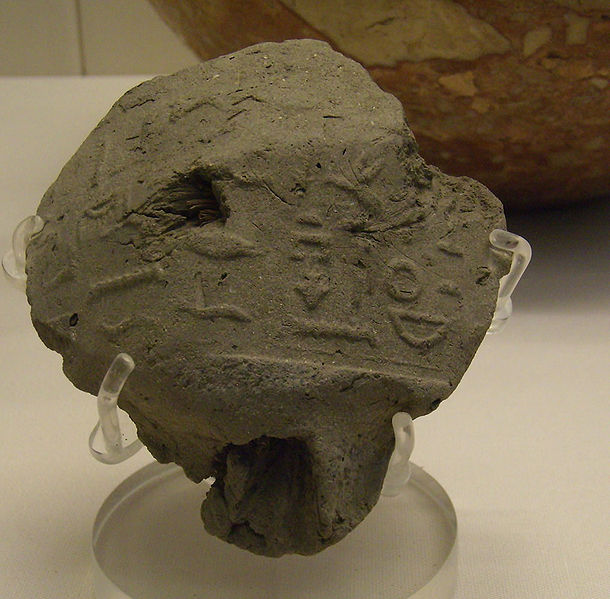
A clearer drawing of the inscription

The inscription says: "The golden one/He of Ombos hath unified/handed over the two realms for/to his son, the king of Lower and Upper Egypt, Peribsen". "He of Ombos" is thought to be a name of Seth"
The cartouche
Link to a detailed discussion of how was this Pharaoh and the theories behind his name

Other inscriptions associated with this Pharaoh

One of the more interesting aspects of the Umm el-Qaab necropolis is that it was here that the first sentence in hieroglyphics is found and also the first Royal names written within a cartouche.
These 'firsts' are found in the tomb of the Pharaoh Peribsen known as Seth-Peribsen or Ash-Peribsen. Unlike many other pharaohs of this dynasty, Peribsen is well-attested in the archaeological records but not the historical record. His name doesn't appear in the Saqarra, Abydos king lists, nor Manetho's Aegyptica. Peribsen's royal name is a subject of interest for Egyptologists as it differs from the traditional practice with its connection to the deity Seth instead of Horus.

A clearer drawing of the inscription

The inscription says: "The golden one/He of Ombos hath unified/handed over the two realms for/to his son, the king of Lower and Upper Egypt, Peribsen". "He of Ombos" is thought to be a name of Seth"
The cartouche
Link to a detailed discussion of how was this Pharaoh and the theories behind his name

Other inscriptions associated with this Pharaoh

new topics
-
Joe Biden gives the USA's Highest Civilian Honor Award to Hillary Clinton and George Soros.
US Political Madness: 1 hours ago -
Winter Storm
Fragile Earth: 2 hours ago -
Biden Face Planted Somewhere
Politicians & People: 3 hours ago -
A great artist and storyteller, for kids of all ages
General Entertainment: 4 hours ago -
What Is 'Quad Demic'? Mask Mandate Returns In These US States
Diseases and Pandemics: 8 hours ago -
The Future of fashion .
Social Issues and Civil Unrest: 8 hours ago -
Bin Cyber Junk…
Short Stories: 9 hours ago -
The Undertones - Teenage Kicks
Music: 10 hours ago -
Volcano Watch 2025
Fragile Earth: 10 hours ago
top topics
-
What Is 'Quad Demic'? Mask Mandate Returns In These US States
Diseases and Pandemics: 8 hours ago, 9 flags -
Joe Biden gives the USA's Highest Civilian Honor Award to Hillary Clinton and George Soros.
US Political Madness: 1 hours ago, 8 flags -
Volcano Watch 2025
Fragile Earth: 10 hours ago, 7 flags -
The Future of fashion .
Social Issues and Civil Unrest: 8 hours ago, 7 flags -
Bin Cyber Junk…
Short Stories: 9 hours ago, 6 flags -
Biden Face Planted Somewhere
Politicians & People: 3 hours ago, 4 flags -
Winter Storm
Fragile Earth: 2 hours ago, 4 flags -
The Undertones - Teenage Kicks
Music: 10 hours ago, 3 flags -
A great artist and storyteller, for kids of all ages
General Entertainment: 4 hours ago, 3 flags
active topics
-
Volcano Watch 2025
Fragile Earth • 6 • : rickymouse -
Joe Biden gives the USA's Highest Civilian Honor Award to Hillary Clinton and George Soros.
US Political Madness • 12 • : 38181 -
Winter Storm
Fragile Earth • 10 • : rickymouse -
The Future of fashion .
Social Issues and Civil Unrest • 18 • : KrustyKrab -
Tesla Cybertruck Explodes in Front of Trump Hotel in Las Vegas
Mainstream News • 221 • : fringeofthefringe -
Strange fog all over the northern hemisphere
General Conspiracies • 49 • : Irishhaf -
Biden Face Planted Somewhere
Politicians & People • 6 • : NoCorruptionAllowed -
My personal experiences and understanding of orbs
Aliens and UFOs • 37 • : Compendium -
What Is 'Quad Demic'? Mask Mandate Returns In These US States
Diseases and Pandemics • 26 • : Xtrozero -
Judge rules president-elect Donald Trump must be sentenced in 'hush money' trial
US Political Madness • 17 • : Vermilion
8

